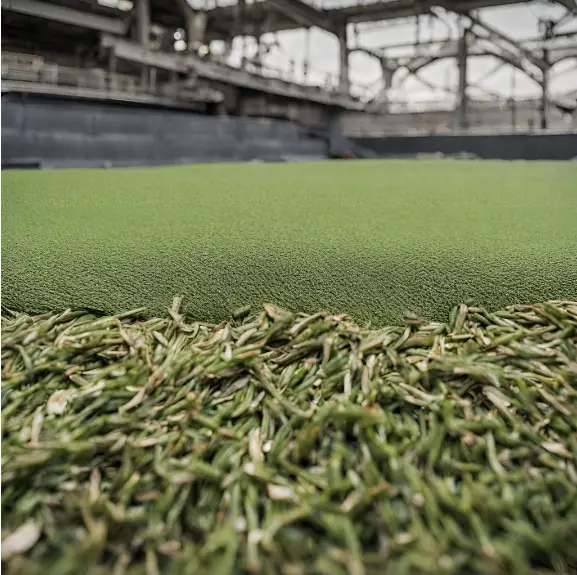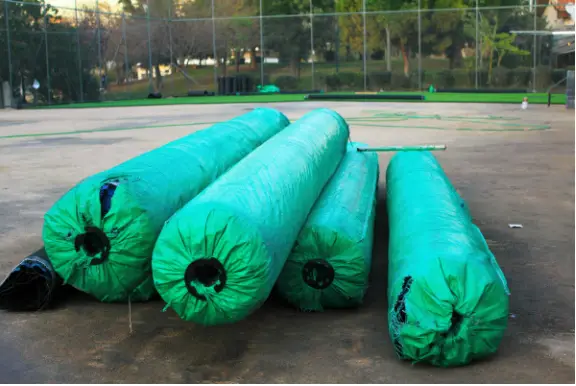Swept Under the Rug: Transforming Past Artificial Turf Mistakes to a Nature-Based Future

In Santa Clara County, both the Fremont Union High School District and the Los Gatos-Saratoga High School District have faced significant decisions to make regarding the construction of new fields: will they be natural grass or synthetic turf systems? School districts have made some mistakes in the past. Now that we in California are wiser, will we do better with our second chance? Early indications are not especially promising.
This article continues our previous one about artificial turf, which you can read here.
It was as recently as 2015 that then-Governor Jerry Brown signed AB 1164. At that time, California was experiencing a 4-year drought, with no end in sight; Governor Brown issued an executive order directing the State Water Resources Control Board to make water reductions across the state aiming to save 25% of water use. Further, it mandated the replacement of 50 million square feet of lawn space with drought-tolerant landscaping.
There was a major flaw in how the bill defined “drought-tolerant landscaping”, though. It stated in part, “Among a wide variety of drought tolerant landscaping are a variety of native plants and landscaping alternatives, including the installation of synthetic grass or artificial turf.” In fact, this section, in its original form, went on to prohibit cities and counties in California from banning synthetic grass and artificial turf, because at the time, they were expected to become an effective part of drought-tolerant landscaping.
But, since 2015, we have learned that artificial turf has drawbacks that are even more significant than we believed. An artificial turf system generally consists of a plastic carpet backing, plastic “blades of grass”, and cushioning infill, which is typically made from silica sand and perhaps tire crumb rubber, cork, crushed walnut shells, or various other infill components. All of these (save some of the alternative infills) are petroleum products, and they can break down into microplastics.
Artificial turf causes can cause heat islands that reach 175ºF; the Santa Clara County Medical Association cites an artificial turf temperature reading over 200ºF. The plastic in turf can also contain toxic materials such as polycyclic aromatic hydrocarbons (PAHs), PFAS, phthalates, benzene, arsenic, styrene, zinc, cadmium, chromium, VOCs, SVOCs, neurotoxicants, phthalates, crystalline silica, latex, and particulate matter. Pesticides and biocides used to kill staphylococcus, among other microbes, can cause adverse skin reactions.
The good news is that the state legislature passed a new bill, SB 676, that specifically excludes synthetic grass and artificial turf from its definition of drought-tolerant landscaping. Unfortunately, Governor Newsom vetoed a second bill, AB 1423, that would have prohibited artificial turf from containing PFAS. This veto was disappointing, but the governor clarified that he fully supports the bill’s intent but found its oversight lacking; this gives hope that the legislature and governor will be able to pass a bill in 2024.

What Can I Do?
As a parent, as a citizen and as a tax payer, make your voice heard.
- Do your diligence starting with the Links listed below. The SCCMA Environmental Health Committee Page is especially useful.
- Join local efforts like Community for Natural Play Surfaces and Ban Plastic Turf
- Keep up to date by subscribing to the SSV Newsletter
- Ask your elected officials their position on artificial turf and tell them you’ll vote according to their answer.
A third bill, SB 499, was given the title School Extreme Heat Action Plan Act of 2023, but sadly was unable to pass during the calendar year. It would require each facilities’ outdoor surfaces, such as cement, asphalt, and artificial turf, to be replaced at their respective end of life with a surface with higher specific heat, like grass, trees, wood chips, etc. This bill is currently in the Assembly’s Appropriations Committee suspense file.
The major issue driving artificial turf installation last decade was a desire to conserve water. But now Valley Water, the major water authority for Santa Clara county, no longer assists property owners with helping them install synthetic turf as part of a drought-resistant landscape. This is consistent with the policies of Cal Water and other area water authorities. As Valley Water’s fact sheet points out, artificial turf isn’t part of a living landscape; doesn’t increase plant, animal, or insect biodiversity; doesn’t provide a habitat for fauna; doesn’t foster healthy soils, and doesn’t sequester carbon.
Natural green spaces provide an environment that reduces stress and helps the health, development, and wellbeing of children and adults alike. The tactile and sensory benefits of natural grass are lost using only a synthetic version. Zhang (2020) says, ““It is evident that time spent in, or exposure to, green space can improve positive mood and emotions, provide a retreat from daily hassles, and reduce the risk of psychological and physiological stress in adolescents. There is also evidence of lasting mental health benefits of green space exposure in childhood.”
Children are particularly vulnerable to toxins in artificial turf because of their immature immune systems; children playing soccer and football are more likely to inhale, ingest, and come into contact with the artificial surface. Finally, there is still evidence that risk of sports injuries on artificial turf, particularly in football and soccer, is increased, as well as the promotion of antibiotic resistant bacterial infections.
Links
Santa Clara County Medical Association Environmental Health Committee Information Page
Safe Healthy Playing Fields Main Site
Safe Healthy Playing Fields Costs: Grass Vs. Synthetic Turf
York Daily Record Worn out artificial turf fields pose huge waste problem across nation
Beyond Plastics Synthetic Turf is HAZARDOUS-
Institute for Climate Change, Environmental Health, and Exposomics Artificial Turf Health Risks
Synthetic Turf Fields Are Failing (YouTube)
NLPA Only Natural Grass Can Level The NFL’s Playing Field
PEER Artificial Turf – A Plague on the Earth
Beyond Plastics Parks for a Sustainable Future Program
National Center for Health Research Injuries Related to Artificial Turf